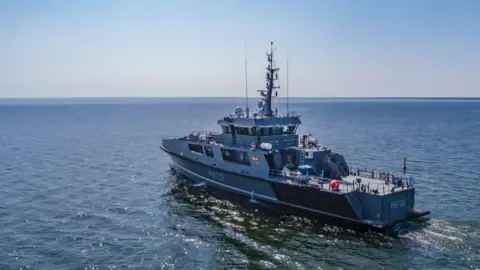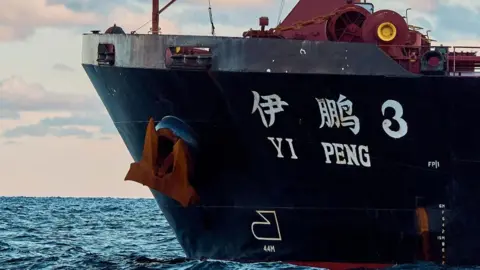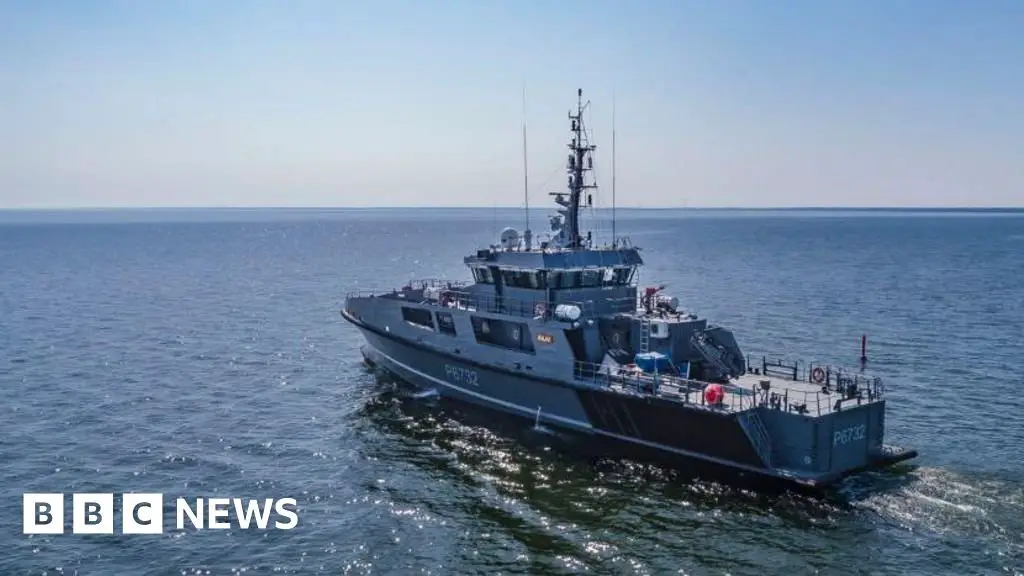 Estonian military
Estonian militaryNATO has said it will increase its military presence in the Baltic Sea and Estonia has sent a patrol ship to protect its Estlink1 submarine cable after Russia was accused of sabotaging its main power link in the Gulf of Finland.
A ship called Eagle S is suspected of damaging the Estlink-2 cable, and the Finnish Coast Guard crew boarded the oil tanker and steered it into Finnish waters.
The EU said the Eagle S was part of “Russia’s shadow fleet” and that the submarine cable failure was the cause the “latest in a series of suspected attacks on critical infrastructure”.
Estonian Defense Minister Hanno Pevkur said the Raju set sail early on Friday and he expected Finland to join the operation to protect the remaining cable.
He told Estonian public broadcaster that the Raju’s job was to “ensure that nothing happens there and that our important connection with Finland remains functional.”
The Kremlin refused to comment on the damage to the cable, describing it as a “very narrow matter” and not a matter for the Russian presidency.
NATO Secretary General Mark Rutte said on social media that he had spoken to Finnish President Alexander Stubb, adding NATO would increase its presence in the Baltics. Another statement from the alliance said only that “NATO remains vigilant and is working to provide further support.”
Finland and Estonia are both NATO members and Estonian Prime Minister Kristen Michal said on public television that if necessary they would invoke Article 4 of the NATO treaty, which provides for consultations if a member state feels threatened.
“Our wish would be to receive reinforcements from NATO in the form of a fleet as a deterrent,” he told the BNS news agency.
Estonia’s power supply has been drastically reduced after the 170km Estlink-2 cable was shut down.
In its initial assessment on Thursday, Finnish company Fingrid said repairs to the cable could last until the end of July 2025.
The damage to Estlink 2 is the third incident in just over a month in the Baltic Sea.
Last month, two data cables were cut: on November 17, the Arelion cable between the Swedish island of Gotland and Lithuania, and then the C-Lion-1 cable between the Finnish capital Helsinki and the German port of Rostock was damaged.
A Chinese ship, the Yi Peng 3, was suspected of dragging its anchor over the cables in a separate Russian act of sabotage.
 EPA-EFE/REX/Shutterstock
EPA-EFE/REX/ShutterstockIn October 2023, another Chinese ship destroyed an undersea gas pipeline between Finland and Estonia.
Both the Yi Peng 3 and the Eagle S are suspected of being part of a so-called shadow fleet of oil tankers that Russia is using to evade Western sanctions imposed since the large-scale invasion of Ukraine.
The EU said it was working on measures, including sanctions, to target “Russia’s shadow fleet, which poses a threat to security and the environment.”
After spending several weeks anchored in the Kattegat between Sweden and Denmark, the Chinese tanker was finally boarded by authorities from Sweden, Denmark, Germany and Finland, but then set sail last week.
In contrast, Finnish authorities said they boarded the Cook Islands-registered Eagle S in the early hours of Thursday and escorted it from Tallinn towards the Finnish coast off Porkkala via the Gulf of Finland.
“Our patrol ship traveled to the area and could visually determine that the ship’s anchor was missing,” Markku Hassinen, deputy head of the Finnish Border Guard, said at a news conference.
The Estonian Prime Minister wanted to reassure Estonians on Thursday that they would continue to have a secure electricity supply.
The two largest utilities, Elering and Eesti Energia, have various reserve and back-up power plants, he told reporters.
However, he added that it is impossible to protect every square meter of the seabed at all times.






